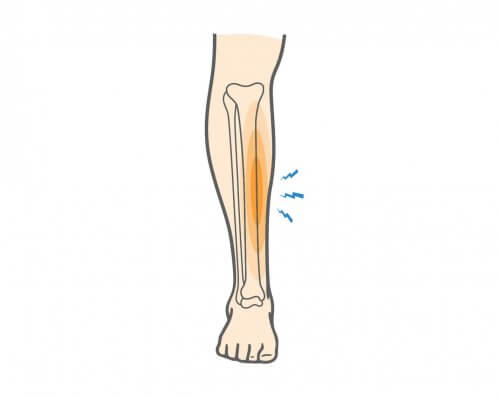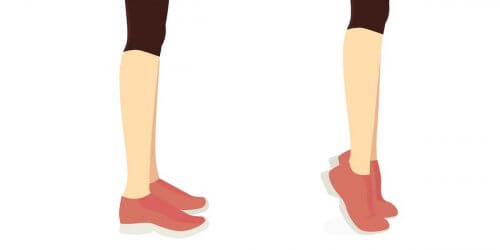5 Ways To Get Rid of Shin Splints

What Are Shin Splints Exactly?
Shin splints occur when muscles, tendons, and bone tissue around the tibia are inflamed. The leg pain most often occurs along the tibia, where the muscles attach to the bone.
The technical term for them is medial tibial stress syndrome; although, very few people know them by that name.
What Causes Shin Splints?
Caused by repetitive movement, in particular, high-impact activities like running on hard surfaces. That repetitive stress on the shinbone and connective tissue results in pain at the front of your lower leg.
Risk Factors for Shin Splints:
- Running
- Increasing mileage too fast
- Sudden increase in intensity of workouts
- Athletes with flat feet or high and rigid arches
- Ill-fitting shoes – click here to read how running shoes should fit.
Symptoms of Shin Splints
There are clear indicators of shin splints. They include pain in the shin area (around the calf muscles and lower leg muscles), soreness on the inner side of the shin bone, swelling in the lower leg, and tenderness.

When you first notice shin splints, the discomfort might end if you stop working out. However, after a bit, your shin splints can get so bad that they hurt no matter what you are doing.
When my shin splints get bad, I start to get pain from simple walking as well.
How To Treat Shin Splints?
There are 5 easy ways to treat shin splints:
- New running shoes
- Rest
- Ice packs
- Anti-inflammatory medicine
- Warm up stretches
The first thing to note is if you catch it early, sometimes you can get by with a few days off and a new pair of running shoes.
I recognize this is not true of everyone, but when I wear a pair of shoes too long, my shins start to ache. If I listen to my body and retire those shoes very quickly, the pain sometimes goes away almost immediately!
If you are wondering how to get rid of shin splints, listen up! Normally, the number one thing the body needs is rest from your exercise routine.
Ice packs are another fantastic way to deal with them. You should ice for 15 minutes or so, anywhere from 4-6 times a day.
Anti-inflammatory pain killers such as ibuprofen can also be used to help you deal with shin splint pain. Some people find that shoe inserts or shock-absorbing insoles and orthotics are great treatment options.
There are also some excellent warm up stretches you can do if you are battling shin splints.
Stretches for Shin Splints
Shin Stretch: With the tops of your feet flat on the floor, kneel on the floor. Putting your hands behind your body to hold your weight, lift up on your knees while you rock back.

Low Lunge Ankle Stretch: Get into a very low lunge. The back leg should be very far back. The front leg should have your knee quite a bit further in front of your foot. Hands-on, the ground, reach and stretch forward.

Calf Raises: Stand up on your tip-toes and hold the stretch. Release and repeat.

Forearm Plank: Planks work more than just core strength. If done with proper form, they help strengthen your shins also!

Simple Leg Balance: Stand on one leg, and lift the other leg up, bending it. Use your arms for balance.

Long Seated Calf Stretch With Resistance Band: Sit with your back straight and legs straight in front of you. Hook the band on your foot. Pull back with resistance bands to get a good stretch. Release, then repeat.

Evan Jensen, , shared some great tips on how to BULLET-PROOF yourself from SHIN SPLINTS.
*Evan Jensen is a member of our RunnerClick Pro community. To join our private, growing community of passionate runners, click here.
Should You Tape Shin Splints?
You can purchase kinesiology tape to tape up your shin splints. The tape job you do and how it should look depends on if you are experiencing anterior, posterior, or lateral shin splints.
What is the difference, and where does the pain present?
- Anterior shin splints are felt in the front of the tibia.
- Posterior shin splints are felt on the inside of the lower leg.
- Lateral shin splints are on the outside front of the lower leg.
For assistance on taping shin splints, this YouTube video can give you guidance.
Can You Still Run With Shin Splints?
If you continue to run with shin splints, you are not giving your body time to heal. This is a mistake. You can actually set yourself back further by continuing to try and run through the pain.
As a coach, I am often asked, “How long do shin splints last?” The answer is about 3-4 weeks. And that is if you are doing what you are supposed to do.
They can stretch on much longer if you push things too long and wait to start the healing process.
Is It Ok to Walk With Shin Splints?
Most people find that they can walk if they are working their way through shin splints. In other words, recreational walking should not make your symptoms worse as running would.
If walking causes you pain or discomfort, you should find another source of exercise until you are healed.
What Should You Not Do With Shin Splints?
If you have shin splints, you should avoid running. You should also avoid putting too much weight on the shins in the beginning. If you enjoy strength training or to cross train, be very careful regarding any type of leg work.
While working your way through shin splints, exercises you can do include the elliptical, cycling, walking, yoga, and other non-impact exercises such as swimming.
There are plenty of ways to get your sweat on that will not make your symptoms worse!
How to Stay Healthy and Avoid Shin Splints
Instead of asking how to get rid of shin splints, reread this article to be sure you can avoid them.
The main ways to avoid shin splints are not to increase mileage or intensity of exercise too quickly, always replace shoes in a timely manner and pay attention to your body.
If your shins start to hurt, pay close attention to what you are asking it to do.
You are better to take a few rest days early on and seek medical advice and physical therapy than to risk being sidelined with excruciating pain later on. Be smart and be proactive!
Latest Articles
 Is Running on a Treadmill Easier Than Running Outside?Runners have their own preferences, whether it is treadmill running, running outside on the road, or exploring trails. So...
Is Running on a Treadmill Easier Than Running Outside?Runners have their own preferences, whether it is treadmill running, running outside on the road, or exploring trails. So... Is It OK to Use Trail Running Shoes on the Road?While trail running shoes can be used on roads, especially in situations where a runner encounters mixed terrains or pref...
Is It OK to Use Trail Running Shoes on the Road?While trail running shoes can be used on roads, especially in situations where a runner encounters mixed terrains or pref... How to Fix Sore Quads After Running?Rest, ice, gentle stretching, and over-the-counter pain relievers can help soothe sore quads after running. Also, ensure ...
How to Fix Sore Quads After Running?Rest, ice, gentle stretching, and over-the-counter pain relievers can help soothe sore quads after running. Also, ensure ... 10 Fruits With The Most Electrolytes to Replace Sports DrinksThese fruits are high in electrolytes such as potassium, magnesium, and calcium, essential for hydration, muscle function...
10 Fruits With The Most Electrolytes to Replace Sports DrinksThese fruits are high in electrolytes such as potassium, magnesium, and calcium, essential for hydration, muscle function...

